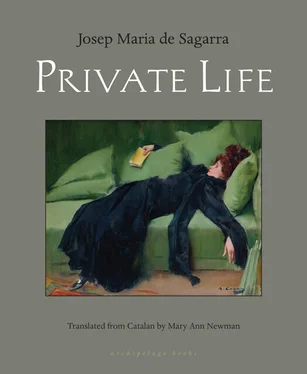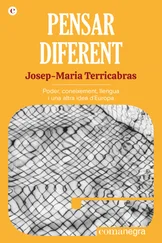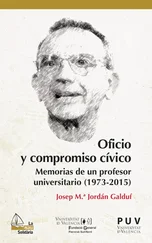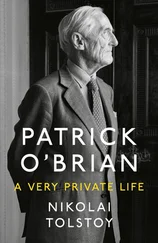Josep Maria de Sagarra - Private Life
Здесь есть возможность читать онлайн «Josep Maria de Sagarra - Private Life» весь текст электронной книги совершенно бесплатно (целиком полную версию без сокращений). В некоторых случаях можно слушать аудио, скачать через торрент в формате fb2 и присутствует краткое содержание. Год выпуска: 2015, ISBN: 2015, Издательство: Archipelago, Жанр: Современная проза, на английском языке. Описание произведения, (предисловие) а так же отзывы посетителей доступны на портале библиотеки ЛибКат.
- Название:Private Life
- Автор:
- Издательство:Archipelago
- Жанр:
- Год:2015
- ISBN:978-0-914671-27-5
- Рейтинг книги:3 / 5. Голосов: 1
-
Избранное:Добавить в избранное
- Отзывы:
-
Ваша оценка:
- 60
- 1
- 2
- 3
- 4
- 5
Private Life: краткое содержание, описание и аннотация
Предлагаем к чтению аннотацию, описание, краткое содержание или предисловие (зависит от того, что написал сам автор книги «Private Life»). Если вы не нашли необходимую информацию о книге — напишите в комментариях, мы постараемся отыскать её.
for its contemporaries, was a scandal in 1932. The 1960's edition was bowdlerized by Franco's censors. Part Lampedusa, part Genet, this translation will bring an essential piece of 20th-century European literature to the English-speaking public.
Private Life — читать онлайн бесплатно полную книгу (весь текст) целиком
Ниже представлен текст книги, разбитый по страницам. Система сохранения места последней прочитанной страницы, позволяет с удобством читать онлайн бесплатно книгу «Private Life», без необходимости каждый раз заново искать на чём Вы остановились. Поставьте закладку, и сможете в любой момент перейти на страницу, на которой закончили чтение.
Интервал:
Закладка:
But Níobe had ideas of her own, and an ambition that was as hard, red and shiny as a dove’s heart cherry. It didn’t take her long to find a Russian painter who ate mussels while listening to the guitars of Posilippo and hunted little scamps at a lira a head to replicate the intimate proclivities of the Emperor Tiberius. Níobe cast her tutu to the winds and coiled herself around the Russian’s neck. He did her no harm, and he showed her how to twirl her spaghetti around her fork, and, en passant, the path to glory. Níobe made the leap to Moscow, and from Moscow to Paris, always coiled around the neck of someone who frequented fine restaurants. In Paris she became saturated with surrealism. The Countess of Noailles made her a gift of a pipe, and a woman from the Madrid aristocracy gave her a man’s suit.
One day she realized that Paris was not good for her biliary secretions, and she ensconced herself in a cove on the Costa Brava to practice a little nudism in the company of two poets and two Pomeranians. From the Costa Brava she leapt to the Passeig de la Bonanova in Barcelona, where for four years now she has owned a bar, an operating room, and a swimming pool. At this point she began to host the heterogeneous society we recently mentioned.
Níobe Casas wasn’t exactly sure why she was called Níobe, or why she was called Casas. As she tumbled from place to place she had used nomenclatures taken from botany, perfumery and distillery. In Barcelona she called herself Níobe Casas, and these two names were probably suggested to her by a professor of archaeology whose skin was as deeply tanned as his soul — much like the sand in the Swimming Club, to which the archaeologist was inseparably attached.
Physically, Níobe was sublime artifact. She was brown as a smoke-blackened pipe, with dark eyes that shone like a beetle’s carapace with a near-violet metallic gleam. She had a brazen, somewhat brutish nose, broad at the base, a mouth from deep within a Gauguin painting, and hair like a great shock of platinum silk, as firmly disciplined by the comb a gigolo’s. All of which made of Níobe’s head an effigy to behold with squinting eyes, in a game of thrust and parry, while sucking in the rouged extract of heavenly savagery that radiated from her cheeks.
Níobe’s body had nothing to do with humanity. Diminutive, compact, as tightly wound as a ball of twine, it bore a zoological kinship to a mongoose or to the mythical Madagascar maquis, half-human, half-ape. To a normal man’s eyes, her arms and hips served up a paradox of attraction and repulsion. The fingers of her hands, long, black and slender, ended in ten silvery nails, a gaudy, horrible, offensive silver. Níobe wore a variety of clothes around the house. She was just as likely to wear pajamas pants with a nude torso, fastening around her breasts a pair of sporty goggles meant to be worn in a convertible, as a mechanic’s overalls, or a long skirt paired with a discreet neckline. The décor of the apartment was done exclusively in glass and nickel, except for the piano, which was a standard Steinway. Her kitchen was the bar. Only cold food was served and drinks didn’t stray from the Rips Bar book of cocktails, with illustrations by Paul Colin. As the reader can see, she lived and ate worse than a member of a chain gang. She spent many hours each day feeding tiny morsels of foie gras to her fish, or she sat by the swimming pool, wrapped in a terry cloth robe, wearing espadrilles with laces, blowing soap bubbles, chewing gum, or lying stretched out on the ground with a hot water bottle on her stomach.
Níobe spoke Catalan with a peculiar lisp, pronouncing her esses more like shushes , mixing in Gypsy expressions and French from la Villette. She didn’t practice any known religion and she made love exactly like an amoeba.
Níobe’s dances had a relationship with the death penalty across climes and cultures. They were akin to industrial mechanics and the customs of insects. They required a minimum of music, a couple of South African chords and nothing more. She asserted that Stravinsky was a twit, and only barely tolerated Schönberg. She didn’t wear any clothes at all when she danced; she would camouflage her skin, as they did with ships during the war. She did it with lively, matte colors, and more or less pre-Columbian motifs. If the audience required discretion, she would don the tiniest possible cache-sexe decorated with the wings of the Spanish fly. But if the audience was made up of regulars, she wore nothing.
All these delights made Níobe a powerful magnet for devotees of communism and transcendental nonsense. Níobe had two female friends: one was Amèlia Nebot, a young bourgeois woman who had left her husband to go off and study bel canto in Milan. She gave concerts at the Palau de la Música Catalana, wrote articles on feminism for radical weeklies, and attended a penya , a youth group devoted to cultivating cacti and to Soviet poetry. Among the members of that penya were two young sketch artists not precisely known for their virility. Amèlia Nebot was fat and common, and she practiced spiritualism. Níobe’s other female friend, more an admirer than a friend, is already known to the reader: Teodora Macaia.
Teodora pressed for an invitation to one of Níobe’s intimate gatherings, and never left. Teodora went to dinner with Níobe at the Colón and the Hostal del Sol. Níobe wouldn’t touch anything but caviar and canned asparagus. Teodora wolfed her food down and, while she was at it, provided Níobe with new admirers. She introduced Níobe to Hortènsia Portell, but the widow didn’t want anything to do with her. To her, the gypsy from Tarragona seemed like an overly crude tango.
With the coming of the Republic, Teodora let go even a little more than she had before. She had been separated from her husband for a long time now. She had an official lover. Not only that, when she went to Paris she spent her time chasing down chauffeurs. As Teodora came from one of the finest families, these things were no obstacle to her appearing at the forefront of all cultural and elegant solemnities. Teodora still had a welcoming voice and the bearing of a true lady. She was one of the few women left in Barcelona with whom a slightly skeptical gentleman could feel right at home.
For Teodora, admiration for Níobe was way to pass the time; for some of her female friends and relatives it was a reason to skin her alive.
Níobe kept an eclectic stew of admirers simmering. First among them was Professor Pinós. Pinós had studied Romance philology at Halle, and did a lot of work for the Fundació Bernat Metge for classical literature. His was the sappiest and most venal kind of erotic temperament. He was known to have some half dozen lovers, all forty or older. He spent all his time traveling to international conferences and eating at indigestible banquets. With the excuse of dancing a chotis , typical in Madrid, he would spend Sunday afternoons at the Ritz smelling every folkloric Spanish armpit that showed up. He attended all the rhythmic gymnastics festivals, was married to a nymphomaniac from Aragon, and had a son who wanted to be a priest.
Doctor Pinós compared Níobe Casas to the Orphic dancers, pre-Doric civilization, and Dionysian phallus worship. Níobe listened to him as if she were hearing a dog bark. He had tried to gain entry to the intimacy and delights of the gypsy woman, but Níobe would shrink back into her shell like the Pagarus bernardus crab; the only favor she would concede was to allow him to dive naked into her swimming pool and fish for a sponge with his teeth.
Her second admirer was Miquel, the essayist. Miquel was another academic full of twaddle. He made his living training typists in the ways of culture. Miquel was at the antipodes of an honorable man. Irascible and pedantic, he brooked no humor. Grafted onto his Catalan were strains of Homeric dialect and Argentine tango. Those who knew him asserted he was the most grotesque man in Barcelona.
Читать дальшеИнтервал:
Закладка:
Похожие книги на «Private Life»
Представляем Вашему вниманию похожие книги на «Private Life» списком для выбора. Мы отобрали схожую по названию и смыслу литературу в надежде предоставить читателям больше вариантов отыскать новые, интересные, ещё непрочитанные произведения.
Обсуждение, отзывы о книге «Private Life» и просто собственные мнения читателей. Оставьте ваши комментарии, напишите, что Вы думаете о произведении, его смысле или главных героях. Укажите что конкретно понравилось, а что нет, и почему Вы так считаете.












